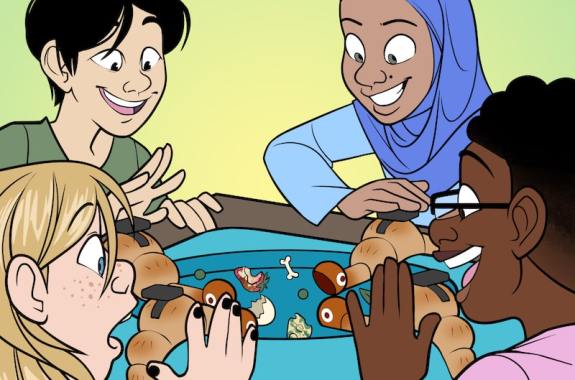Grade Level
6 - 8
minutes
Multi-day
subject
Mathematics
Activity Type:
data analysis, engineering and design challenge, project-based learning
The name Hermetia illucens is a lot prettier than the face of the insect it represents!
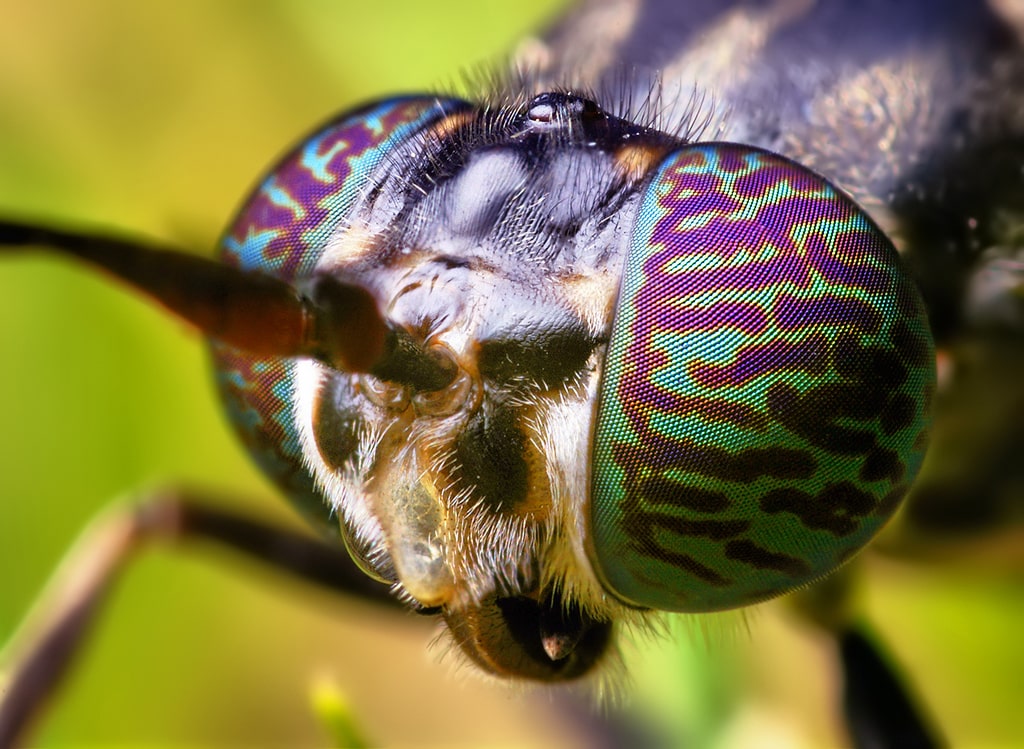
Hermetia illucens is also known as the black soldier fly. The larvae of the black soldier fly are not going to win a beauty pageant either, but what they lack in aesthetics they make up for in ambition. What these guys do best is eat, and these ugly little guys can really eat… a lot. On average, a black soldier fly larva will consume twice its body mass on a daily basis. Imagine a 150 pound human eating 300 pounds of food in a day every day for two weeks. These tiny monsters pull off this feat on a regular basis. It’s a good thing that they do eat so much. During the duration of their two-week larval stage, black soldier fly larvae will consume all the food they will use for the rest of their lives. They’re so committed to stocking up at their larval stage that their adult forms don’t even have mouths. After the larvae pupate for another two weeks, they begin a short 5-9 days as adults. As adults, they spend their time solely on creating the next generation of black soldier flies.
Why Is This Important?
The next time you open your fridge, take a moment to check out the food inside. Specifically, take a look at the expiration dates on some of the packages. Look at some of the things on the back of the shelves or maybe those forgotten vegetables in the drawers. Odds are high that you will find some food that is past its prime. That food is likely to end up in the trash instead of your stomach.
One-third of the food that goes into restaurants and our homes ultimately ends up in landfills instead of being eaten. As it decomposes, that biodegradable waste creates a water-polluting sludge. When you consider the carbon footprint needed to grow and transport that food in the first place, the problems become magnified.

Remember our Hermetia illucens larvae? Black soldier fly larvae can create an interesting solution to this food waste issue. By having the black soldier fly larvae eat the waste, much of it will never see a landfill. Businesses known as larva farms already exist, where large amounts of commercial food waste is consumed by massive numbers of black soldier fly larvae. Some of the fattened larvae are then sold as food for amphibian or reptile pets, or for poultry, while others are kept through adulthood to create the next generation of larvae. Farming the larvae creates an efficient system that incentivizes companies to address the problem of food waste using a profitable solution. This method, although efficient, still has some flaws, but it seems that it could be a really helpful way to eliminate some of the problems in landfills.
David Hu of Georgia Institute of Technology, working with his team, has identified one of the problems that goes along with how to best utilize these voracious eaters for all their potential benefits.
Though they eat a lot, a single soldier fly larva feeds for only 15 minutes each hour. During the other 45 minutes, the soldier fly larva’s body takes up real estate, lounging in front of food scraps, and keeping other larvae from getting to the food. This is one of the problems that Hu and his team are trying to address: How can you best harness the eating power of these hungry hungry flies when one larva may only eat for only 15 minutes each hour, and may keep others from eating for the remaining 45 minutes?
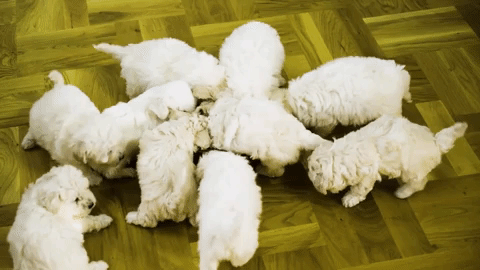
You can think of this problem like puppies at a food bowl. When you look at the GIF, you can probably guess where the dish is! Unfortunately for the puppies, there simply isn’t enough space for them all to feed at once. Maybe it would help to create a larger bowl that they can all fit around? Black soldier fly larvae run into the same conundrum. There simply isn’t enough space for all of the larvae to be able to eat simultaneously without some larvae effectively blocking others from eating.
Hu’s team has determined that the movement of a black soldier fly larva is often dictated by the movement of the surrounding larvae and the presence of food. When food is present the larvae begin to move causing the ones in the surrounding area to also begin moving as well. This creates, as Hu calls it, a “buffet line” where each member of the line takes a bite and then is pushed out of the way for the next larva to take a bite. Because of this movement, black soldier fly larvae are able to eat larger quantities of food than would be expected without this shifting. Watch a video profile on Hu and his team’s research in the Science Friday Macroscope video below.
Given this amazing ability to eat, let’s investigate a way to use this eating power to help us solve a problem. The question to investigate: Can the food waste produced by your school be eliminated using black soldier fly larvae instead of being sent to the dump?
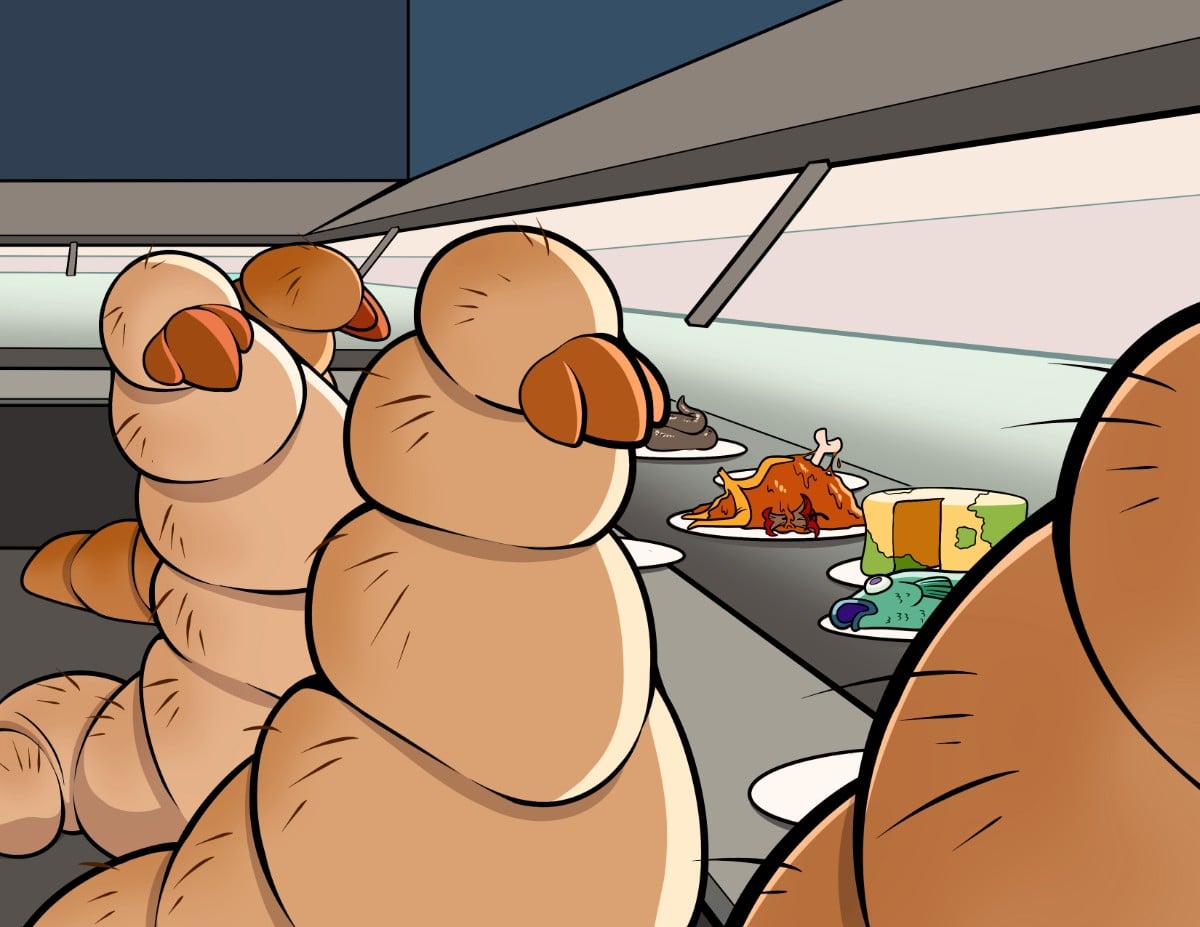
The Very Hungry Maggot
Activity One: Setting The Standard For Massive Waste
The implications of using black soldier fly larvae goes beyond the food waste in restaurants and homes. There are about 31.6 million students who use the National School Lunch Program across the United States. Providing each student with additional fruits and vegetables costs about $5.4 million per day, but $3.8 million in fresh fruit and vegetables end up in the trash each day. This amounts to a tremendous amount of food waste, but that’s a story for another project. We want to look at the massive amount of food headed to the landfill based on the trash from these fresh fruits and vegetables, which doesn’t even include other unfinished food products.
First, let’s find out how your class does when it comes to eating all of your food. We are going to weigh the amount of food thrown away by our class each day for the next five days.
Materials
- 1 large trash can, preferably on wheels and lined with two trash bags. Heavy duty trash bags decrease the less chance of having a lot of clean up later. The trash can should be available with a fresh bag for each day of the activity.
- A scale
- A class of students
- Loaves of bread
- Gloves
- Any type of plastic container. Clear is preferred so students can best observe.
- Poster board or blank printer paper
- Student engineering notebook
- 100 black soldier fly larvae
Teacher Procedure
- Without telling your students what the activity is beforehand, give them a trash can (lined with a plastic trash bag) to deposit only food waste from their lunch for just that day. It’s incredibly important that they don’t put in any other materials from bags, to trays, plasticware, bottles, cartons, etc. You can spend lunch with the students, invite them into your room to eat lunch, or even assign a student without giving them a heads up on what the activity will be to make sure the special trash can only gets used for food waste.
- After lunch, answer the following questions on page 16 of the student notebook:
- Do you eat everything you pick up from the cafeteria or bring to school?
- How many grams of food do you think you throw away each day at school?
- What do you think would be the easiest way to reduce the amount of food waste from your school knowing not everyone will always eat all their food?
- How many grams of food did you throw away today? How many grams of food do you think that your whole class threw away today?
- How much food do you think that your class sends to a landfill in a month? A school year?
What Does A Gram Look Like?
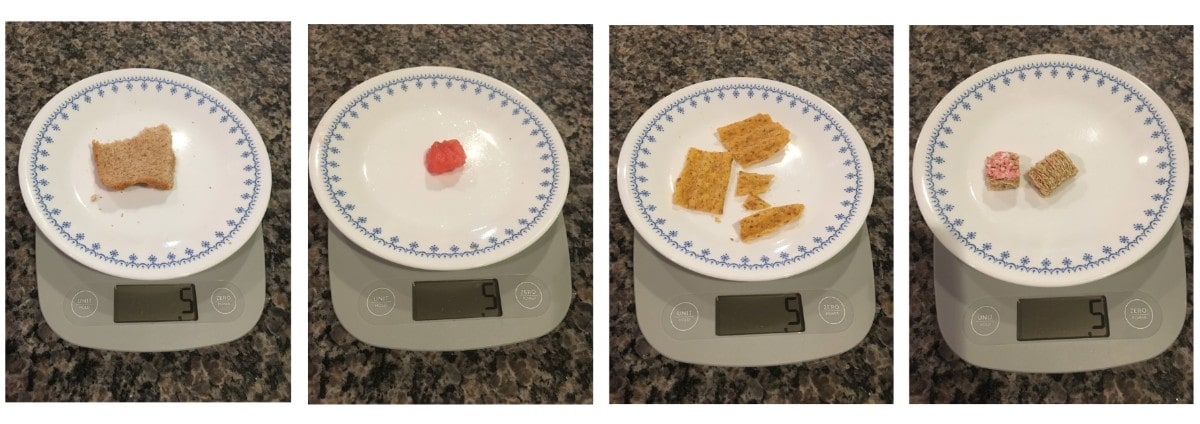
Credit: Brian Soash - Weigh the trash collected from lunch today. One way to weigh the entire bag is to have a student stand on a scale without the trash bag. Record his/her weight. Now have the student stand on the scale while holding the bag. Subtract the weight of the student with the trash minus the student’s weight without the trash. You may need to change the weight from pounds to grams. (Once the trash is weighed and discussions for the day are completed, the trash can be disposed of properly.) Calculate the average amount of food waste per person per day from your class. To do this, divide the total weight of the food by the number of people in the class who contributed today.
Note: It’s ok that not everyone eats the same amount, the same thing, or the same way. This number is an average, and will be used to create a baseline for your study. - What does the amount of food per person per day look like? Use your calculation for the average amount of food waste per person per day to create that same mass using a piece of bread. (Bread is recommended because it’s cheap, readily available, and the slices make it easier to help find the right mass. You can, however, use any type of food item you have readily available to you.)
- Place the mass of bread or other food items in your plastic container with approximately 100 black soldier fly larvae and allow students to make observations about what they see when the food is added. Note: Bread works well when it comes to finding an exact mass. It does, however, crumble easily, which means losing potential mass once the larvae begin eating it. This can lead to potential loss of mass when taken out to be measured for your experiment. Fruit, like an apple, or a vegetable, like a potato wedge, will hold together, but can create an odor faster as well as lose moisture, leading to a change in mass that isn’t because it was consumed by larvae. Pick the food item that best meets the environment of your classroom.
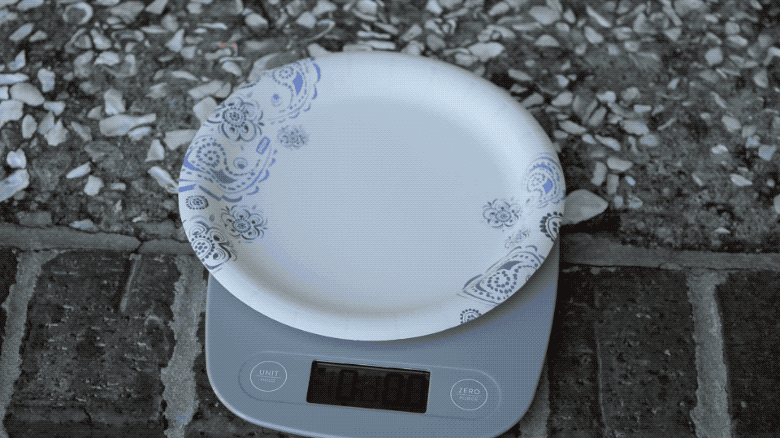
Credit: Brian Soash - After 24 hours, measure the mass of the remaining bread or other food put into the container the previous day. Be sure to remove any larvae that may still be feasting in the food before weighing.
- Use this data to find the daily food waste that can be consumed by 100 fly larvae along with the amount of food consumed each day by one larva and the rate of food consumed per cubic centimeter of space in your lava container. There are pages in your Hungry Hungry Hermetia Notebook that will help you with the calculations once the measurements have been completed.
Activity Two: Create A Plan
Now that you have seen how effective soldier fly larvae are at consuming food waste, you’ll design your own setup for using soldier fly larvae to consume your classroom food waste efficiently. Work with your classmates to determine your design for a black soldier fly composting system that could consume the average daily food waste created be your class. Consider the rate at which the food waste was consumed by your baseline of 100 larvae over the course of 24 hours. Use your observations as well as the background information about Hu’s research to inform your design.
- Before you pick your team, go to page 16 of your student notebook and answer the three questions about food waste in the cafeteria and in your daily life. You can use the example images of what 5 grams of food looks like on page 16 if needed to help you answer the questions.
- Next, form a team with your classmates to determine your design for a black soldier fly composting system that could consume the average daily food waste created by your class.
- Start your collaboration by sharing and discussing the answers from page 15 of the student notebook from each group member.
- Answer the driving question for this project on page as a group. “Can the food waste produced by our school be eliminated using black soldier fly larvae instead of being sent to the dump?” It is on page 19 of your student notebook.
- Use your observations as well as the background information about Hu’s research to inform your design on pages 20-23 in your notebook. These pages will help your group decide what information is needed to complete the project, what Hu’s team has discovered so far, and quantify the food waste created by your class on a regular basis. Remember your goal as a group should be to find the answer to the question. Consider the rate at which the food waste was consumed by your baseline of 100 larvae over the course of 24 hours.
Design Considerations That Should Be Taken Into Account:
- Ensure that all food waste is consumed within the two weeks that black soldier flies spend feeding in the larval stage.
- Create a method where food waste can be dealt with on a daily basis without having to “skip” a day of food waste collection. An example of a system you would want to avoid creating would be a system that would only be able to used to dispose of the food waste from your school every other day.
- Know the number of black fly larvae needed in your design or system in order to create the system able to handle food waste on a daily basis.
- Create a model that could potentially be made big enough to deal with the food waste from your entire class.
- Efficient systems that do not waste space, larvae, or materials are the most ideal and practical as solutions. For example, don’t create a system that uses 5 million larvae to deal with the waste of one person.
Your group should explicitly state the dimensions of your design, the number of larvae needed, the materials needed for your design, and any special features that it may need such as a lid, hatch that opens and closes, or method of collecting food waste. Each component of your system should be described in terms of what material it’s made of, its size, and its purpose in your notebook. If any special steps are needed to prepare food or the larvae before you use your model, be sure to describe those as well.
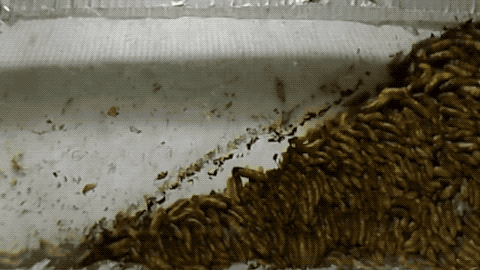
The ‘Wet-Dog Shake’ And Other Physics Mysteries
Activity Three: Test Your Design
Materials
- A large number of fly larvae, which can be purchased at a relatively low price
- One type of food to use across all designs for consistent results between different groups
- Extra plastic containers such as old plastic food containers
- Scale
Teacher Note: It may be helpful to set a cap to the number of larvae that can be used to ensure you have enough for each group and that one group doesn’t hoard all of the larvae.
Build your food waste black soldier fly system with your group. Be sure to take pictures as you build to document your progress. After you’ve finished your design use the template in the student notebook to describe the process you took to create it using page 24-27 in your student notebook.
After you’ve finished building, make a prediction about how effective your design will be on page 28 of your notebook. Using the scale provided by your teacher, use bread or some other food item to create the same average mass of food waste per student you determined earlier. Place your larvae and your food into your system and measure your results for the rate of food waste consumed 24 hours later. Be sure to calculate how much food is consumed every 24 hours as well as the hourly food consumption rate for a larva and record your data on pages 29-34.
*You’re encouraged to go through this process at twice or more if time permits for even better results!
Teacher Note: After finishing with the larvae, they make great food for pets such as amphibians, reptiles, and poultry.
Activity Four: Review It
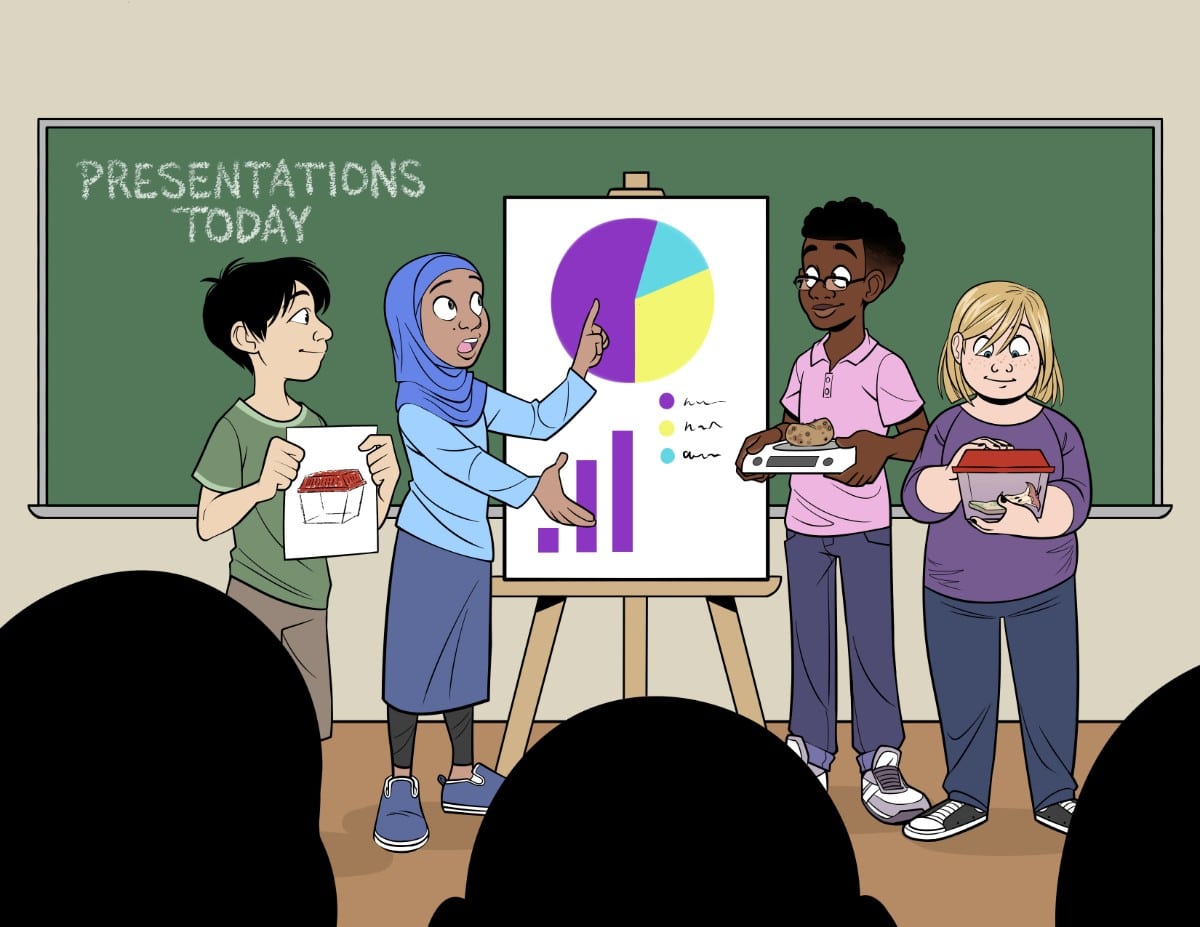
Create a summary of your results. Using a poster board, blank printer paper, or electronic device create a visual summary of your findings. Be sure to highlight the ability of your system to quickly and effectively eliminate food waste, the rate of food that was consumed 24 hours later, the size of the container needed to do it, and the number of larvae needed.
Share your design and findings with the other teams from your class. Be sure to document the differences in design and share your feedback with the group using the feedback form. Record the rate of food consumption for each design, and determine if the ratio of number of larvae used to grams of food consumed between groups are proportional to each other.
Activity Five: Scale It And Share It
Review the findings from your work as well as the feedback from the other teams to create an improved system that could deal with the food waste from your entire class. Size of your design, number of larvae, additional materials needed, and procedures for how to operate the system should be detailed.
Create an infographic, small scale model, or other visual aids to best represent your system, its function, how it addresses the class food waste problem, and the rate which you should be able to dispose of food waste that makes your design exceptional. Invite your school cafeteria workers, maintenance, and school or district administration to come to a fair-style event. Convince those attending to check out the designs and which system would work best to solve the question of, “Can the amount of food waste sent to the dump produced by our school be reduced or eliminated using fly larvae?”
How To Be A Vibration Detective
Reflection Questions
Provide reasoning using specific evidence from your investigation to support the claims you make when answering each question.
- In your opinion what design features made a design successful?
- Did the rates of grams of food consumed every 24 hours and the number of larvae use between groups form a proportional relationship?
- In your opinion, is solving the problem of food waste at your school something that can be solved by any of the designs generated by your class?
- Based on the consumption rates determined from testing your design, how many larvae would it take to consume the food waste generated by your class in only 24 hours?
- Based on your testing results, how many cubic centimeters of space would be required to eliminate the food waste from your whole class?
- Ask your teachers for the number of classrooms in your school. How many larvae would be needed to eliminate all the food waste created at your school within 24 hours if you assumed every classroom produced the same amount of daily food waste as your class?
- Based on your testing results how many cubic centimeters of space would be required to eliminate the food waste from your whole school?
- Companies like Fluker’s sell black soldier fly larvae as food for reptile and amphibian pets. Based on the current price that this company sells 1,000 of their larvae, how much money could your school raise if you sold half of the larvae required in question #6 every two weeks? How much money could your school raise in a month? How much could they raise in a 10 month school year?
- In your opinion is using black soldier fly larvae as a means of recycling food waste a reasonable solution? What will you do with all the adult flies leftover?
Rubric For Reflection Questions
| Criteria | 3 | 2 | 1 |
|---|---|---|---|
| Claim | Claim is stated explicitly and is easily found as the first component of the student’s answer. | Claim is stated using any indirect manner at the start of a student’s answer. | Claim is not clear and/or is not the first component of a student’s answer. |
| Claim | Claim is stated explicitly and is easily found as the first component of the student’s answer. | Claim is stated using any indirect manner at the start of a student’s answer. | Claim is not clear and/or is not the first component of a student’s answer. |
| Evidence | Student uses evidence directly from the work or findings from the activity. The student explicitly states where the evidence can be found and where it came from. | Student uses evidence directly from the work or findings from the activity. There is no citation provided to where that information can be found. | Student uses no evidence or uses strictly anecdotal evidence not from the activity. |
| Reasoning | Reasoning is provided that directly supports the claim and uses the evidence previously provided. Reasoning is provided after the evidence and is not simply the evidence provided. | Reasoning provided is simply the statement of the evidence without further explanation or reasoning provided is flawed. | Reasoning provided does not directly relate to the evidence supported or is inaccurate. |
Extension: The Perpetual Composter
Using your knowledge from the Science Friday Video and other outside research, can you develop a system with your team that could not only properly recycle the waste, but create additional black soldier fly larvae to continually deal with food waste outside of the first two weeks? How could your system be adapted to handle the school’s waste on a daily basis? Could you create a process of generating funds from your system to purchase additional supplies, black soldier fly larvae, or other supplies that may be needed?
Standards
CCSS.MATH.CONTENT.6.RP.A.1
Understand the concept of a ratio and use ratio language to describe a ratio relationship between two quantities. For example, “The ratio of wings to beaks in the bird house at the zoo was 2:1, because for every 2 wings there was 1 beak.” “For every vote candidate A received, candidate C received nearly three votes.”
CCSS.MATH.CONTENT.6.RP.A.2
Understand the concept of a unit rate a/b associated with a ratio a:b with b ≠ 0, and use rate language in the context of a ratio relationship. For example, “This recipe has a ratio of 3 cups of flour to 4 cups of sugar, so there is 3/4 cup of flour for each cup of sugar.” “We paid $75 for 15 hamburgers, which is a rate of $5 per hamburger.”
CCSS.MATH.CONTENT.6.RP.A.3
Use ratio and rate reasoning to solve real-world and mathematical problems, e.g., by reasoning about tables of equivalent ratios, tape diagrams, double number line diagrams, or equations.
NGSS Science Standards:
MS-LS2-5. Evaluate competing design solutions for maintaining biodiversity and ecosystem services.
ETS1.B Developing Possible Solutions There are systematic processes for evaluating solutions with respect to how well they meet the criteria and constraints of a problem
Credits:
Resource written by Brian Soash
Original art by Adri Tibbs
Edited by Ariel Zych, Shirley Campbell, and Lauren Young
Digital Production by Lauren Young and Brian Soash
Educator's Toolbox
Meet the Writer
About Brian Soash
@BSoashBrian Soash was Science Friday’s educator community leader. He worked to connect educators, schools, and districts with the outstanding educational content being developed by Science Friday.
